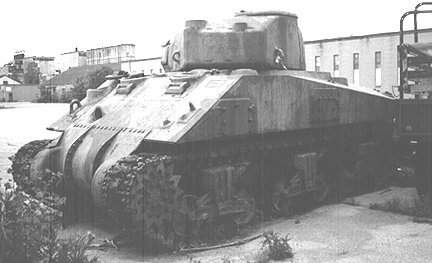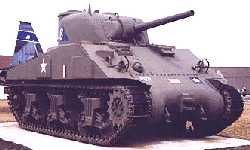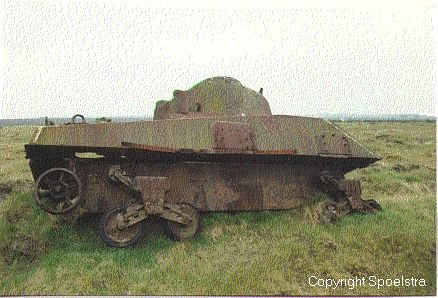Canadian
Indestructible
Roller Device (CIRD)
|
While being a very useful
vehicle
to deal with mines, the main disadvantage of the Sherman Crab
mine flail
was that it could not be used to search for mine fields. Besides
the fact
that it was very slow when flailing (1.5 mph), the wear on the
flailing
chains when flailing constantly reduced its effectiveness when
mines were
found.
Therefore several other
types of
anti-mine attachments were devised for both Sherman and
Churchill, mostly
in the form of rollers. The most effective of these was made by
the Canadians
and was known as the Canadian Indestructible Roller
Device. It consisted
of two arms attached to the side of the tank, each supporting a
heavy roller.
The roller was suspended in such a way it could jump in the air
and rotate
in an arc round the arm when a mine was detonated, thus reducing
the chance
of the rollers being blown off. Because of this construction, it
did not
have a limited life like the Crab on which chains which wore out
or were
blown off. It also had a higher speed, 5-7 mph and up to 15 on
roads, and
was therefore essentially a reconnaissance vehicle which could
proceed
at normal speeds.
The device was available
for D-Day
and was shipped across the channel. Sherman CIRDs were issued as
pilot
tanks, on the scale of one per troop, to the three regiments of
the 79th
Armoured Division operating flail tanks in North West Europe. RAC
Reports
note that one of these, 30 Armoured Brigade, was equipped with
"36 pilot
Sherman Vs with 12 Roller equipments". However, there are no
records of
the CIRD being used in action and all units were withdrawn before
the end
of 1944.
But it was tested again
around February
1945. Before the crossing of the Rhine the 79th Armoured Division
formed
a number of experimental wings to deal with the problems expected
when
crossing the Rhine. F Wing was based at Geel, Belgium, and (among
other
things) tested a series of anti-mine devices, one of which was
the "spectacular"
CIRD. In December 1945 the Specialised Armour Development
Establishment
(SADE) continued to test the CIRD.
Maybe no more than a dozen
CIRDs
were built. Photographs made during testing show various Sherman
Vs (incl.
T-148350) in use as pusher tanks. No devices themselves are known
to survive,
but a number of Shermans with the distinctive fittings on the
hull sides
are preserved. Noteworthy is that two of them survive in Canada
which is
odd since the CIRD was developed and tested by the Canadian Army
in Great
Britain.
| Surviving Shermans
with CIRD fittings |
 |
This is the first Sherman V
with CIRD
fittings that came to light in recent years. In 1992 Ed Storey
'discovered'
it at Canadian Forces Base Kingston, Ontario, Canada, where it
stood on
the base golf course in the Gore Training Area. Its gun, mount,
engine
and engine deck are missing and the gun aperture in the turret is
plated
over. It is seen here at the Military Heritage Museum, Brantford,
Ontario,
Canada, to where it later moved.
As of March 1999, this
Sherman was being acquired by the Canadian War Museum at Ottawa.
Reportedly, a set of rollers had also been found, but these tuned
out not to be CIRD rollers.
Scan provided by Chris
Johnson. |
 |
This M4A2 at CFB Borden
Military Museum,
Ontario, Canada, has the distinctive patches on the hull sides.
The bolts
to which the CIRD was fitted are missing,
however. Note the hefty hitch welded to the front of the final
drive housing.
Scan courtesy of Fred
Olsen. |
 |
After WW2 a Sherman V with
CIRD fittings
ended up on one of the Commonwealth vehicle dumps in the
Netherlands. It
was taken into service as a normal gun tank by the Royal
Netherlands Army
and issued with registration number 34076. It ended up on a range
were
its shattered remains were photographed before it
disappeared. |
Sources:
-
Dingwall, Don (see the Links
page).
-
Half Yearly Reports on the
Progress
of the Royal Armoured Corps (via Peter Brown).
-
Hunnicut, R.P., Sherman: a
history
of the American medium tank. Second edition. Novato: Presidio
Press,
1978, p.302, 446 (ISBN 0-89141-080-5).
-
Fletcher, David, Vanguard
of Victory:
the 79th Armoured Division. London: Her Majesty's Stationery
Office,
1984, p.28, 29, 30, 56, 59 (ISBN 0-11-290422-X).
-
Fletcher, David, The
Universal Tank:
British armour in the Second World War part 2. London: HMSO,
1993,
p.80, 94, 107 (ISBN 0-11-292534-X).
Back
to Subjects page
Last update: 14-07-1999
Copyright
© 1988-1999
H.L. Spoelstra /
Sherman
Register / All Rights Reserved


